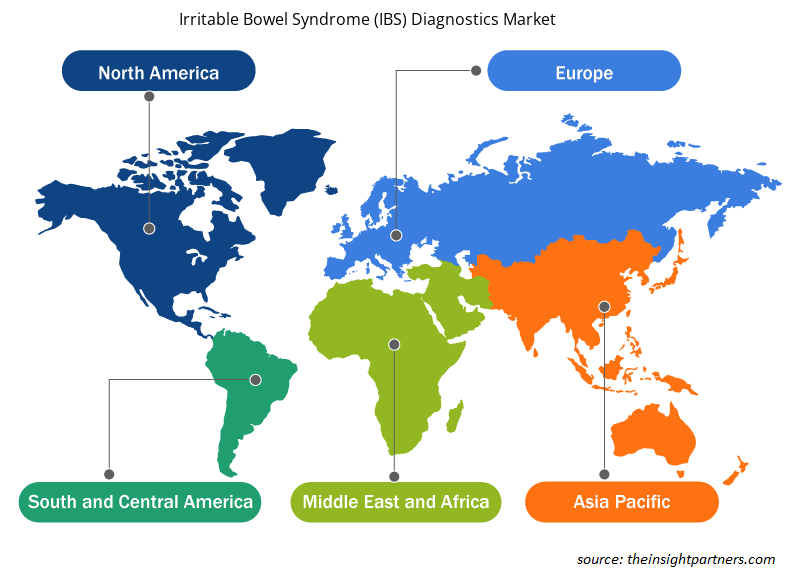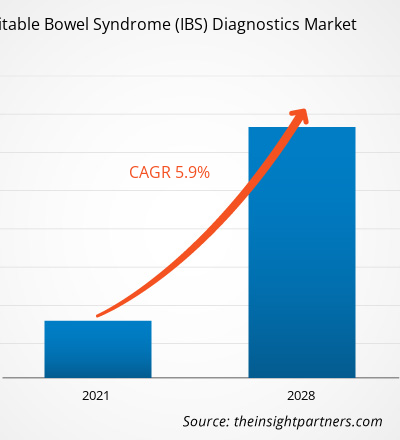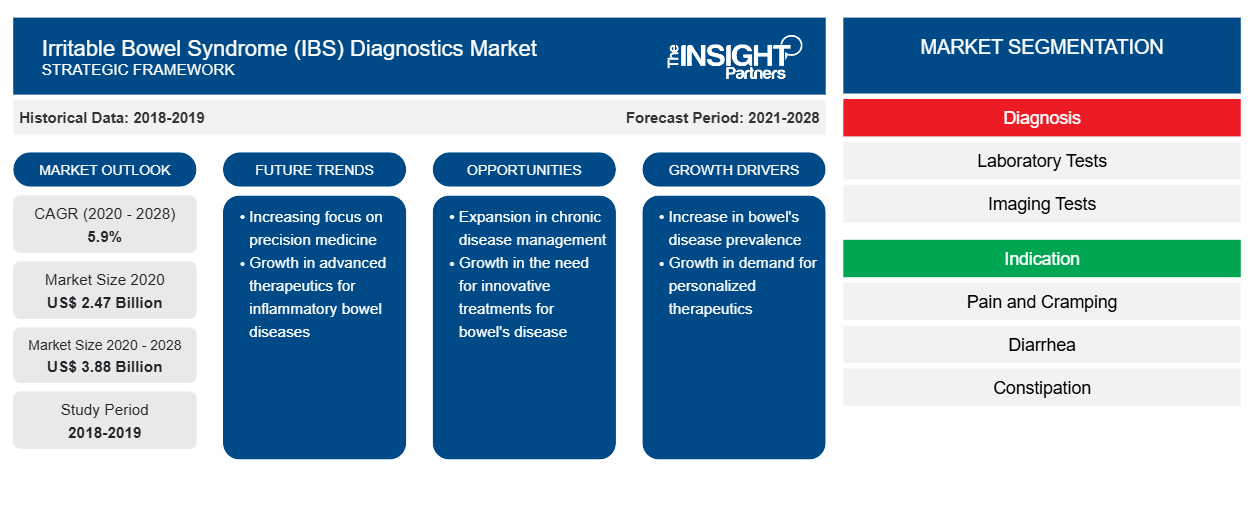Le marché du diagnostic du syndrome du côlon irritable (SCI) était évalué à 2 470,61 millions USD en 2020 et devrait atteindre 3 880,91 millions USD d'ici 2028 ; il devrait croître à un TCAC de 5,9 % de 2021 à 2028.
Le syndrome du côlon irritable (SCI) est défini comme un trouble gastro-intestinal provoquant une gêne gastrique, ainsi que de la diarrhée et de la constipation. Le SCI peut se développer après une grave diarrhée (gastroentérite) causée par des bactéries ou un virus. Le SCI peut également être associé à un excédent de bactéries dans les intestins (prolifération bactérienne). Les personnes exposées à des événements stressants, en particulier dans l'enfance, ont tendance à présenter davantage de symptômes du SCI. Le diagnostic du SCI se fait à partir des antécédents médicaux, d'un examen physique et de tests d'imagerie. Cependant, le SCI est principalement diagnostiqué par des tests d'intolérance au lactose, un test respiratoire pour la prolifération bactérienne, une analyse de sang et un test de selles. Les tests sont effectués en fonction de symptômes tels que la constipation prédominante, la diarrhée prédominante ou mixte. Il peut également être détecté par divers tests d'imagerie tels que la tomodensitométrie ou la radiographie, l'endoscopie supérieure et la coloscopie.
Le marché du diagnostic du syndrome du côlon irritable (SCI) est segmenté en fonction du diagnostic, de l'indication et de la géographie. Par géographie, le marché est segmenté en Amérique du Nord, Europe, Asie-Pacifique, Moyen-Orient et Afrique, et Amérique du Sud et Amérique centrale. Le rapport offre des informations et une analyse approfondie du marché du diagnostic du syndrome du côlon irritable (SCI), en mettant l'accent sur des paramètres tels que les tendances du marché, les avancées technologiques et la dynamique du marché ainsi que sur l'analyse du paysage concurrentiel des principaux acteurs du marché mondial.
Personnalisez ce rapport en fonction de vos besoins
Vous bénéficierez d'une personnalisation gratuite de n'importe quel rapport, y compris de certaines parties de ce rapport, d'une analyse au niveau des pays, d'un pack de données Excel, ainsi que de superbes offres et réductions pour les start-ups et les universités.
-
Obtenez les principales tendances clés du marché de ce rapport.Cet échantillon GRATUIT comprendra une analyse de données, allant des tendances du marché aux estimations et prévisions.
Informations sur le marché
Le syndrome du côlon irritable est une affection gastro-intestinale chronique causée par des troubles du transit intestinal et des douleurs abdominales. La maladie est également connue sous le nom de côlon spastique, côlon irritable, colite muqueuse et colite spasmodique. Le syndrome du côlon irritable se manifeste par des symptômes tels que des douleurs abdominales, de la constipation, de la diarrhée et des crampes.
Partout dans le monde, les gens sont témoins d’une incidence considérable du syndrome du côlon irritable. Selon les données publiées par la Fondation internationale pour les troubles gastro-intestinaux, parmi tous les patients atteints du syndrome du côlon irritable, environ 40 % des personnes souffrent d’un syndrome du côlon léger, environ 35 % d’un syndrome du côlon modéré et environ 25 % d’un syndrome du côlon sévère. Les allergies alimentaires, les stades en développement de la gastro-entérite, les mouvements sporadiques du côlon, la composition anormale de la sérotonine dans le côlon et la maladie cœliaque légère font partie des facteurs de risque qui provoquent le syndrome du côlon irritable. Selon une étude publiée sur NCBI en 2018, le syndrome du côlon irritable toucherait environ 10 à 16 % de la population américaine chaque année. De plus, selon le rapport d’impact mondial sur le syndrome du côlon irritable, en 2016, la prévalence moyenne estimée des différents pays variait de 1,1 % en France et en Iran à 35,5 % au Mexique. L'Amérique latine avait un taux de prévalence de 17,5 %, l'Asie de 9,6 %, l'Amérique du Nord/Europe/Australie/Nouvelle-Zélande de 7,1 %, et le Moyen-Orient et l'Afrique de 5,8 %. Une prévalence aussi stupéfiante du syndrome du côlon irritable est susceptible de stimuler le marché du diagnostic du syndrome du côlon irritable (SCI) au cours de la période de prévision.
Pour lutter contre le syndrome du côlon irritable, les acteurs du marché prennent des mesures constructives pour créer des programmes de sensibilisation auprès de la population. Par exemple, en 2018, la collaboration d'Allergan PLC et d'Ironwood a lancé une plateforme de destination numérique interactive pour encourager les patients à s'informer et à agir. De même, en janvier 2018, Commonwealth Diagnostics International, Inc. a collaboré avec le golfeur professionnel américain Rob Oppenheim pour sensibiliser au syndrome du côlon irritable (SCI) et à la prolifération bactérienne de l'intestin grêle (SIBO).
Le nombre croissant d'approbations de la FDA et de développements de diagnostics contribue de manière significative à la croissance du marché
Le nombre croissant d'approbations de la FDA et d'activités de développement de diagnostics devrait accélérer la croissance du marché des diagnostics du syndrome du côlon irritable (SCI) au cours de la période de prévision. La majorité des acteurs établis ainsi que de nouveaux acteurs se présentent pour développer et fabriquer des solutions de diagnostic pour la maladie, ce qui conduira à une large disponibilité des solutions de diagnostic sur le marché. Par exemple, en février 2020, Commonwealth Diagnostics International (CDI), Inc. a relancé l'IBSchek, le premier test sanguin de biomarqueur cliniquement validé pour le syndrome du côlon irritable de type mixte (SCI-D, SCI-M) et la diarrhée prédominante dans un nouveau kit de prélèvement capillaire à domicile. De plus, en octobre 2018, Gemelli Biotech a lancé l'IBS-smart, une innovation dans les tests sanguins pour le syndrome du côlon irritable (SCI), en partenariat avec le Medically Associated Science and Technology Program (MAST) de Cedars-Sinai.
Le marché du diagnostic du syndrome du côlon irritable (SCI) devrait connaître l'approbation de solutions de diagnostic, ce qui aura à terme un impact positif sur la croissance du marché. Par exemple, en juin 2019, BÜHLMANN Laboratories AG a reçu l'autorisation 510(k) de la Food and Drug Administration (FDA) des États-Unis pour son test automatisé de calprotectine BÜHLMANN fCAL turbo et son test ELISA de calprotectine BÜHLMANN fCAL. Selon les estimations de l'entreprise, le test devrait connaître des ventes florissantes sur le marché mondial.
Informations sur le diagnostic
Sur la base du diagnostic, le marché mondial du diagnostic du syndrome du côlon irritable (SCI) est segmenté en tests de laboratoire et tests d'imagerie. En 2020, le segment des tests de laboratoire détenait la plus grande part du marché. De plus, le segment devrait détenir la plus grande part de marché d'ici 2028. La croissance du marché est principalement attribuée à la prévalence croissante du syndrome du côlon irritable (SCI) dans le monde, qui devrait se poursuivre dans les années à venir en raison de troubles des habitudes intestinales et de douleurs abdominales. Cela, à son tour, stimule la demande de diagnostic de ces maladies dans le monde entier.
Informations sur les indications
En fonction des indications, le marché mondial du diagnostic du syndrome du côlon irritable (SCI) est segmenté en douleurs et crampes, diarrhée, constipation et alternance de constipation et de diarrhée. Le segment de la douleur et des crampes détenait la plus grande part de marché en 2020 et devrait encore dominer le marché d'ici 2028. Les antispasmodiques et les antidépresseurs sont des médicaments utilisés pour traiter la douleur et les crampes du SCI.
Les lancements de produits, les fusions et acquisitions sont des stratégies très répandues sur le marché mondial du diagnostic du syndrome du côlon irritable (SCI). Quelques-uns des développements récents de produits clés sont énumérés ci-dessous :
En février 2020, Commonwealth Diagnostics International (CDI), Inc., a annoncé le relancement commercial d'IBSchek, le premier test sanguin biomarqueur cliniquement validé pour le syndrome du côlon irritable à prédominance diarrhéique et de type mixte (IBS-D, IBS-M) dans un nouveau kit de collecte capillaire à domicile.
En janvier 2019, Gemelli Biotech a annoncé un partenariat avec Advanced Medical German Co. (AMG), basé au Koweït, l'un des principaux distributeurs internationaux de produits et services médicaux au Moyen-Orient. Grâce à ce partenariat, AMG distribuera le test sanguin de diagnostic exclusif de Gemelli pour le syndrome du côlon irritable, ibs-smart, dans les principaux territoires du Moyen-Orient et d'Afrique du Nord, notamment le Koweït, les Émirats arabes unis, le Qatar, l'Arabie saoudite, l'Égypte et la Turquie.
La pandémie de COVID-19 devrait avoir un impact positif significatif sur le marché du diagnostic du syndrome du côlon irritable (SCI). La majorité des sociétés pharmaceutiques du monde entier sont engagées dans le développement de vaccins contre la COVID-19. De plus, le syndrome du côlon irritable (SCI) est fréquemment déclenché par le stress lié à la COVID-19. Ainsi, les kits de test à domicile sont préférables aux tests en laboratoire, car les services de laboratoire peuvent être débordés pendant la pandémie, ce qui devrait avoir un impact positif sur les autres segments du marché dans les mois à venir. Cependant, les perturbations de la chaîne d'approvisionnement causées par l'arrêt des opérations mondiales entravent la croissance du marché.
Aperçu régional du marché du diagnostic du syndrome du côlon irritable (SCI)
Les tendances et facteurs régionaux influençant le marché du diagnostic du syndrome du côlon irritable (SCI) tout au long de la période de prévision ont été expliqués en détail par les analystes d’Insight Partners. Cette section traite également des segments et de la géographie du marché du diagnostic du syndrome du côlon irritable (SCI) en Amérique du Nord, en Europe, en Asie-Pacifique, au Moyen-Orient et en Afrique, ainsi qu’en Amérique du Sud et en Amérique centrale.

- Obtenez les données régionales spécifiques au marché des diagnostics du syndrome du côlon irritable (SCI)
Portée du rapport sur le marché des diagnostics du syndrome du côlon irritable (SCI)
| Attribut de rapport | Détails |
|---|---|
| Taille du marché en 2020 | 2,47 milliards de dollars américains |
| Taille du marché d'ici 2028 | 3,88 milliards de dollars américains |
| Taux de croissance annuel composé mondial (2020-2028) | 5,9% |
| Données historiques | 2018-2019 |
| Période de prévision | 2021-2028 |
| Segments couverts |
Par diagnostic
|
| Régions et pays couverts |
Amérique du Nord
|
| Leaders du marché et profils d'entreprises clés |
|
Densité des acteurs du marché : comprendre son impact sur la dynamique des entreprises
Le marché des diagnostics du syndrome du côlon irritable (SCI) connaît une croissance rapide, tirée par la demande croissante des utilisateurs finaux en raison de facteurs tels que l'évolution des préférences des consommateurs, les avancées technologiques et une plus grande sensibilisation aux avantages du produit. À mesure que la demande augmente, les entreprises élargissent leurs offres, innovent pour répondre aux besoins des consommateurs et capitalisent sur les tendances émergentes, ce qui alimente davantage la croissance du marché.
La densité des acteurs du marché fait référence à la répartition des entreprises ou des sociétés opérant sur un marché ou un secteur particulier. Elle indique le nombre de concurrents (acteurs du marché) présents sur un marché donné par rapport à sa taille ou à sa valeur marchande totale.
Les principales entreprises opérant sur le marché du diagnostic du syndrome du côlon irritable (SCI) sont :
- Commonwealth Diagnostics International
- Diagnostics de Gênes
- Gemelli Biotech
- Laboratoires Prometheus
- Inova Diagnostics, Inc.
Avis de non-responsabilité : les sociétés répertoriées ci-dessus ne sont pas classées dans un ordre particulier.

- Obtenez un aperçu des principaux acteurs du marché du diagnostic du syndrome du côlon irritable (SCI)
Diagnostic du syndrome du côlon irritable (SCI) – Segmentation du marché
Par diagnostic
-
Tests de laboratoire
- Tests d'intolérance au lactose
- Test respiratoire pour détecter la prolifération bactérienne
- Analyses de selles
- Analyses de sang
-
Tests d'imagerie
- Tomodensitométrie ou radiographie
- Endoscopie supérieure
- Coloscopie
Par indication
- Douleur et crampes
- Diarrhée
- Constipation
- Alternance de constipation et de diarrhée
Par géographie
-
Amérique du Nord
- NOUS
- Canada
- Mexique
-
Europe
- France
- Allemagne
- ROYAUME-UNI
- Italie
- Espagne
- Reste de l'Europe
-
Asie-Pacifique (APAC)
- Chine
- Japon
- Inde
- Australie
- Corée du Sud
- Reste de l'Asie-Pacifique
-
Moyen-Orient et Afrique (MEA)
- Arabie Saoudite
- Afrique du Sud
- Émirats arabes unis
- Reste du Moyen-Orient et de l'Afrique
-
Amérique du Sud et Amérique centrale (SCAM)
- Brésil
- Argentine
- Reste de l'Amérique du Sud et de l'Amérique centrale
Profils d'entreprise
- Commonwealth Diagnostics International
- Diagnostics de Gênes
- Gemelli Biotech
- Laboratoires Prometheus
- Inova Diagnostics, Inc.
- Biohit Oyj
- Aérodiagnostic, LLC.
- Solutions métaboliques, Inc.
- Société Sysmex
- Laboratoires Bühlmann AG
- Analyse historique (2 ans), année de base, prévision (7 ans) avec TCAC
- Analyse PEST et SWOT
- Taille du marché Valeur / Volume - Mondial, Régional, Pays
- Industrie et paysage concurrentiel
- Ensemble de données Excel
Rapports récents
Témoignages
Raison d'acheter
- Prise de décision éclairée
- Compréhension de la dynamique du marché
- Analyse concurrentielle
- Connaissances clients
- Prévisions de marché
- Atténuation des risques
- Planification stratégique
- Justification des investissements
- Identification des marchés émergents
- Amélioration des stratégies marketing
- Amélioration de l'efficacité opérationnelle
- Alignement sur les tendances réglementaires























 Obtenez un échantillon gratuit pour - Marché du diagnostic du syndrome du côlon irritable (SCI)
Obtenez un échantillon gratuit pour - Marché du diagnostic du syndrome du côlon irritable (SCI)